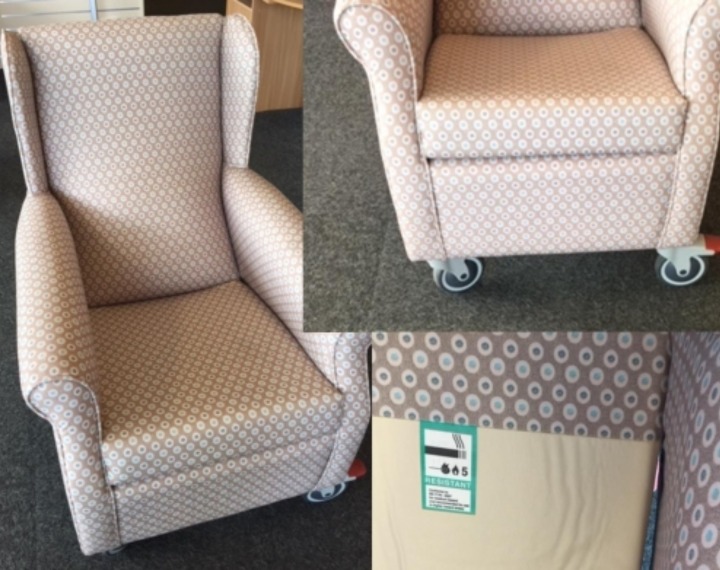Specialist Care Seating Solutions: What Is Good Seating?
 When older people who are frail or suffer from muscular or skeletal health conditions sit in an asymmetrical or unsupported position, this can cause pain and discomfort, including skin and soft tissue damage. This can lead to aches and pains, and potentially even pressure wounds and injuries, that can have a serious impact on their health. This is especially true if they are sat in chairs that cause them to slump over when the person has reduced movement due to age or illness. People who are able to move freely can stand up and take a break from sitting, moving and walking about, whereas people who aren’t able to move unaided don’t have this choice.
When older people who are frail or suffer from muscular or skeletal health conditions sit in an asymmetrical or unsupported position, this can cause pain and discomfort, including skin and soft tissue damage. This can lead to aches and pains, and potentially even pressure wounds and injuries, that can have a serious impact on their health. This is especially true if they are sat in chairs that cause them to slump over when the person has reduced movement due to age or illness. People who are able to move freely can stand up and take a break from sitting, moving and walking about, whereas people who aren’t able to move unaided don’t have this choice.
Seating that isn’t designed to perfectly meet the needs of a senior who spends a lot of time sitting can have a huge impact on their overall health, impacting their breathing, their ability to speak, and various other functions. The problem is that ordinary chairs and wheelchairs lack support, which can lead to people sitting slumped to either side with their chin on their chest. Therefore, ensuring that residents are correctly seated in a care environment should be of the highest priority.
When Specialist Seating is selected, residents can be made more comfortable and can also be encouraged to be more sociable and more involved in the activities being offered by the care facility. The right seating can help to offer older people a better quality of life, which is what makes getting it right so vital.
What is specialist seating?
Specialist seating provides residents in care facilities with the additional support and comfort that they need. This seating offers the ideal combination of functionality and specialist features that enable a person’s body weight and posture to be carefully adjusted throughout the day. This helps to prevent the pressure in one area, leading to pressure ulcers developing.
What is good seating?
When it comes to choosing seating for your care facility, it’s essential to determine what good seating actually is and what it offers to its users. Bearing that in mind, the question is: what does good seating do?
- It will ENABLE not DISABLE function
- It is comfortable, well ventilated and allows the user maximum stability
- It should provide effective pressure relief
- It should be easy to maintain and durable
- It should be well fitted to encourage good posture, pressure management, care and comfort
Emphasis should be placed on the chair fitting the client correctly when deciding upon chair sizing and accessories. Issues around pressure care, moving and handling and infection control issues should also be considered and addressed.
The chair should provide long-term comfort and adequate lumbar support, ensuring good pressure distribution of body weight and enabling the user to rise from the chair easily
Correct seat height
Too High - and the seat is difficult to get into and provides no support for the feet. This can lead to deformities (foot) and encourages the user to slouch so they can rest their feet.
Too Low - and an individual's body weight is supported on a smaller area which leads to more pressure on the coccyx and buttocks. The individual's knees and thighs will lift off the seat surface increasing pressure on a smaller area of the buttocks and bony prominences.
Correct seat width
Too Wide - and the seat offers no support or stability as the body will lean to one side causing an imbalance in pressure. The armrests will be out of reach and since these are crucial to stability the user will lean and shift position to fill the space causing unbalanced pressure distribution.
Too Narrow - and there is an increased risk of pressure to the trochanter area on the outer thigh as well as difficulty getting in and out of the chair.
Correct seat depth
Too Short - and only a small area of the buttocks is supported giving a smaller area of higher pressure on the buttocks and thighs rather than an evenly distributed area at lower pressure levels, this can lead to pressure damage
Too Long - and the user will need to slouch down to get foot support for stability. This position puts pressure on the heels and sacral area and can inhibit circulation to the lower limbs.
What are the different kinds of specialist seating available?
High back chairs
These provide increased support for the head, neck and shoulders, and also increased overall back support. These chairs ensure that people are always sat with the correct posture, helping to prevent painful and dangerous problems occurring.
Plus, studies have shown that even when relaxing, high back chairs can help people to feel more alert and more focused due to how they position the body. Designed to support the lumbar region of the lower back and the sides of the torso, high back chairs offer a fantastic level of support.
What’s great about high back chairs is the fact that not only do they work to prevent injuries and pain from occurring but they also have been proven to reduce feelings of stress.
Rise and recliner chairs
What’s fantastic about rise and recliner chairs is the fact that they are adjustable, allowing the perfect position to be found for maximum comfort. Whether the person is sitting, rising, or has their feet up, or want to recline fully, a rise and recliner chair easily adjusts to fit the person’s needs.
Low back chairs
Designed to offer additional support to the lower back, low back chairs are ideal for people with lower back problems, including general aches and pains. Usually, the backrest that is fitted to these chairs tends to be rather small and is designed to flex back and forth while the person is sitting, moving as they do. The backrest is designed to offer the best lumbar support possible.
Usually, low back chairs are designed for people who sit in these chairs for a short period of time, or who are able to move while in a seated position, and aren’t recommended for people who sit still for longer periods of time. For anyone who has upper back, neck or head problems, this type of chair probably isn’t the best option, but low back chairs are a more affordable option worth considering for certain people.
Bariatric chairs
Bariatric chairs are built to perfectly accommodate people with increased body weight and size. These chairs offer additional back support and extra depth to accommodate the increase in body size, and the special design of these chairs reduces the impact of gravity pulling the body forward. The idea behind this feature is that it decreases the strain on the spine and back, and makes it easier for the individual to remain upright.
There you have it, everything that you need to know about choosing the best seating for your care environment.





